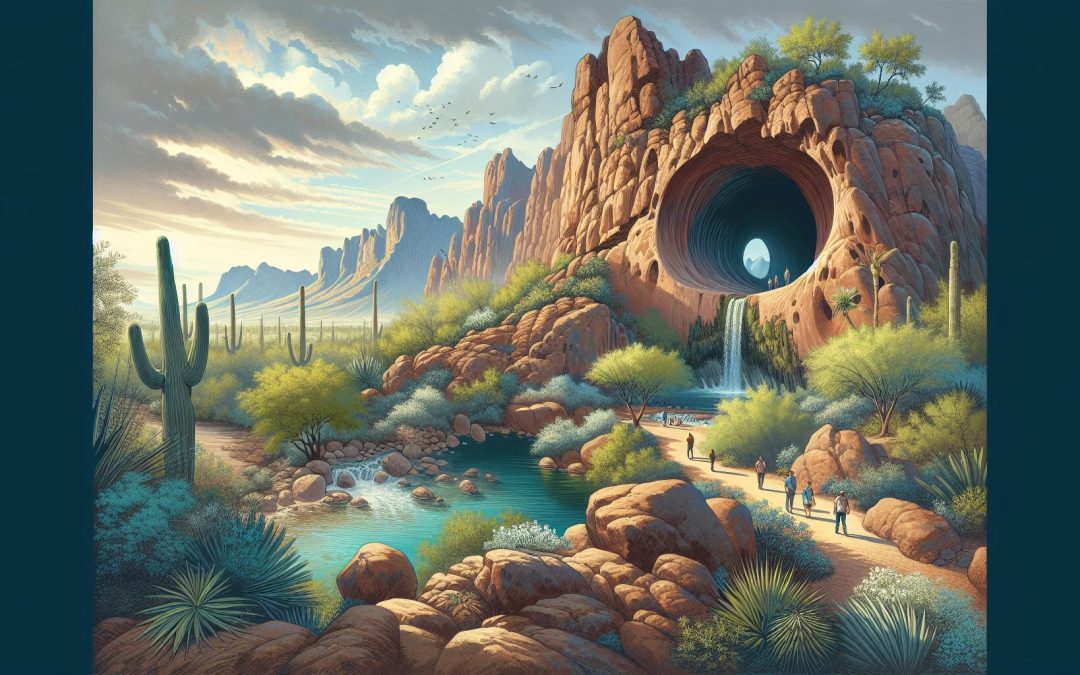Nestled in the heart of Phoenix’s Papago Park, Hole in the Rock isn’t just your ordinary natural landmark. It’s a window to breathtaking views and a testament to the beauty of Arizona’s desert landscape. I’ve always been fascinated by how nature crafts its masterpieces, and this spot is no exception.
The first time I visited, I was struck by the simplicity and grandeur of it all. Climbing through the smooth, eroded sandstone to peek through the ‘hole’ at the sprawling city and azure skies beyond was nothing short of magical. It’s a must-visit for anyone craving a moment of peace or a stunning backdrop for their next photo op.
History of Hole in the Rock
As I dug deeper into the fascinating history of Hole in the Rock, I uncovered stories that truly enhance its allure. Nestled in Papago Park, this natural sandstone formation isn’t just a sight to behold. It’s a chapter from the past, whispering tales of ancient times and recent rediscovery.
Centuries ago, the Hole in the Rock served as a significant landmark for the indigenous tribes, particularly the Hohokam, who inhabited the Phoenix area. They utilized the site not just for shelter but importantly, as an astronomical observatory. The positioning of the holes in the rock formation allowed these early inhabitants to track the solstices and equinoxes. This ingenious use of natural topography speaks volumes about their advanced understanding of celestial movements.
Fast forward to the late 19th and early 20th centuries, when Phoenix was burgeoning, and the American West was the frontier of exploration and settlement. Hole in the Rock began to captivate the imaginations of new settlers and visitors. It wasn’t long before it was established as a must-visit location for those traversing the wilds of Arizona.
In recent years, efforts to preserve Hole in the Rock have highlighted its historical and cultural significance. Efforts by local government and community groups ensure that this natural marvel will continue to be accessible. This stewardship not only preserves its beauty for future generations but also the stories and the history it embodies.
Every visit to Hole in the Rock offers me a chance to step back in time and marvel at the continuity of human interaction with nature. From the Hohokam observers of the skies to modern-day hikers seeking solace and beauty, this landmark stands as a testament to the enduring allure of the natural world.
Formation of the Natural Landmark

As I ventured further into the history of Hole in the Rock, it became evident that its formation wasn’t an overnight phenomenon. Instead, it’s a testament to the slow, yet relentless forces of nature. Shaped over millions of years, this natural sandstone formation owes its existence to a combination of erosion and weathering processes that sculpted its unique appearance.
Geologists estimate that the formation of Hole in the Rock began around 6 to 15 million years ago during the Tertiary period. The primary architect behind this awe-inspiring landmark is none other than water. Rainwater, accumulating acid from the atmosphere, seeped into the cracks of the sandstone, gradually dissolving the bonds holding the sand particles together. Over time, this resulted in the formation of holes and ultimately, the large opening we’re mesmerized by today.
Wind played a crucial role too. As the water widened the cracks, wind-blown sand acted like sandpaper, smoothing and shaping the interior walls of the rock formation. This natural process of erosion gave Hole in the Rock its smooth and rounded contours, making it not just a historical site but a visual marvel as well.
The most significant aspect of this formation is its directional alignment. The opening at Hole in the Rock is uniquely positioned to frame the setting sun during the equinoxes. This phenomenon suggests that the site wasn’t just a result of natural forces but also held astronomical significance for the indigenous tribes like the Hohokam, who might have used it as an ancient observatory.
It’s fascinating to reflect on how natural processes, spanning millions of years, have the power to create landmarks that not only offer scenic views but also act as windows into our planet’s geological past and the early human civilization that once thrived in these regions. As we explore further…
Getting to Hole in the Rock
When I decided to visit the Hole in the Rock, figuring out how to get there was at the top of my list. Located in the heart of Papago Park, Phoenix, it’s surprisingly accessible, which is great news for anyone worried about a long hike. I’ll share my journey and tips so you can make your visit as smooth as possible.
First off, Papago Park is not just about the Hole in the Rock. It’s a sprawling area with loads of attractions, including the Phoenix Zoo and the Desert Botanical Garden. This means you’re in for more than just a scenic view; there’s a whole day of exploration at your fingertips. But back to the main event.
To get to the Hole in the Rock, you don’t need to be an experienced hiker; it’s actually quite an easy path. From the parking lot, which is free (a rare find these days!), it’s a short, well-marked trail. I appreciated that because I’m not the most directionally inclined person. It took me about 5 to 10 minutes to reach the base of the rock formation.
The trail up is gentle but can be a bit uneven, so good walking shoes are a must. I saw families with kids and even a few adventurous elders making the trip without trouble. The path curls around the back before leading up to the main chamber. Here’s a little table with the essentials:
| Feature | Details |
|---|---|
| Location | Papago Park, Phoenix, AZ |
| Trail Type | Short and easy |
| Accessibility | High; suitable for all ages |
| Parking | Free |
| Time to Climb | 5-10 minutes |
At the top, the view is just breathtaking. You’re not just looking at the city; you’re wrapped in a panorama that shifts with the sun. The natural window frames the landscape in a way that’s both dramatic and serene. It’s a spot that invites quiet reflection while you soak in the vistas.
Experiencing the Scenic Views
When I first set foot on the trail leading up to the Hole in the Rock, I was immediately struck by the ease of access. The path, although a bit uneven, was short and well-marked. As I made my way to the top, I couldn’t help but feel a sense of anticipation for the view that awaited me.
Reaching the summit, I was not disappointed. The panoramic view from the Hole in the Rock was nothing short of breathtaking. It’s fascinating how the landscape transforms with the changing sun, from the golden hues of dawn to the fiery colors of sunset. The natural window, carved out by geological processes over millennia, frames the desert landscape perfectly, creating a serene and almost reflective atmosphere. It’s a spot that invites visitors to pause and take in the beauty of the desert.
What makes the experience even more compelling is the variety of photo opportunities. Whether you’re an avid photographer or just someone who appreciates a good backdrop for selfies, the Hole in the Rock provides a unique setting that’s hard to find anywhere else. The contrast of the rock formation against the bright blue sky, especially during the golden hour, makes for stunning photographs.
Aside from the scenic views, the ambiance at the Hole in the Rock is remarkably peaceful. Despite its popularity and ease of access, there’s a sense of tranquility that envelops the place. It’s as if the surrounding landscape absorbs all the noise, leaving only the sounds of nature and the soft whispers of other visitors enjoying the moment.
In addition to the natural beauty, I found the various angles and perspectives from which to view the landscape to be particularly engaging. Moving just a few feet can reveal a whole new vantage point, each offering its own unique composition of the desert landscape. It’s this diversity of perspectives that invites visitors to explore and discover their own favorite spots for reflection or photography.
Preserving Papago Park

While exploring the beauty and serenity of Hole in the Rock, it’s hard not to feel a deep sense of responsibility toward preserving this incredible environment. For me, the conservation efforts in and around Papago Park are as important as the landmark itself. The park’s unique geological features, diverse plant life, and wildlife habitats make it an invaluable resource for education, recreation, and conservation.
Sustainable practices play a key role in maintaining the park’s natural beauty. I’ve observed several initiatives aimed at preserving the landscape, including:
- Trash-free trails: Encouraging visitors to pack out what they pack in.
- Restoration projects: Rehabilitating areas affected by erosion and human activity.
- Wildlife protection programs: Ensuring the safety and health of native species.
Moreover, community involvement has been pivotal. Local volunteers and organizations often host clean-up events and educational programs to raise awareness about the importance of environmental stewardship. Such efforts underscore the communal spirit that’s essential for the long-term preservation of Papago Park.
I’ve also learned that respecting designated paths and observing wildlife from a distance are simple yet impactful ways to minimize our footprint. These practices not only help in preserving the park’s ecological balance but also enhance the experience for future visitors.
Rediscovering Papago Park through the lens of conservation has deeply enriched my appreciation for natural landmarks like the Hole in the Rock. It’s a reminder that these treasures are ours to enjoy, yes, but also ours to protect.
Conclusion
Exploring the Hole in the Rock has been an eye-opener for me. It’s not just about the stunning views or the thrill of discovering a natural landmark. It’s a lesson in responsibility. We’ve got this incredible gift right in the heart of Papago Park, and it’s up to us to ensure it remains pristine for generations to come. By joining clean-up events or simply following the park’s guidelines, we’re doing our part in this collective effort. Let’s keep embracing these sustainable practices. After all, it’s in these small actions that we show our true appreciation for nature’s wonders. Here’s to many more visits, filled with awe and respect for the beauty that surrounds us.







